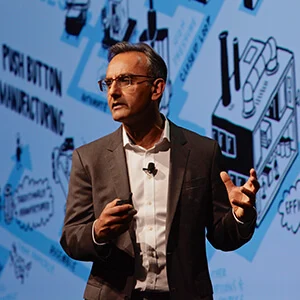& Construction

Integrated BIM tools, including Revit, AutoCAD, and Civil 3D
& Manufacturing

Professional CAD/CAM tools built on Inventor and AutoCAD
Major systemic changes to the manufacturing industry were well underway to converging the physical and digital prior to the widespread disruptions of 2020. And the disruptions aren’t finished. Trends arising from the effects of Brexit, new waves of COVID-19, and the rolling impact of all-digital living and working promise to keep shifting the ground under manufacturing in 2021.
Even before the pandemic shredded plans and targets, manufacturers were struggling to maintain cost effectiveness while adopting or planning to adopt Industry 4.0 digitalization initiatives. In 2021, the manufacturing industry will continue to face economic upheaval, evolving consumer behavior and changes to global trade patterns.
The efficiencies of fusing the physical with the digital in manufacturing—from disruption-ready supply chains to digital upskilling and intelligent automation—are now vital for fulfilling sustainability goals. However, many industry thought leaders also believe this convergence is an existential challenge that firms must take on to succeed. There will be risks to mitigate but, more important, opportunities to grasp as the industry reimagines the new possible.
Here are five ongoing manufacturing trends that will continue to define the near future, with some thoughts on how the industry can respond.
Mass customization may not be new, but demand for personalized products is rising. In saturated product categories, differentiation through features alone is getting harder to achieve. On top of that, 2020 made consumers acutely aware of the things they value most. From fast-moving consumer goods to industrial machinery, customers want products that reflect their individual needs.
This year, manufacturers will have to find ways to satisfy an even more personalization-hungry market on a mass scale. They’ll need to do this while remaining profitable—despite the artisanal overheads that come with bespoke production. Meanwhile, design and manufacturing teams will need to avoid falling victim to product development systems overloaded with customization requests, which can create bottlenecks that kill innovation. Fortunately, as demand takes shape, there will be an opportunity to look again at both pricing and fulfillment. After all, research shows consumers will pay 20% more on average for bespoke products—and wait longer to receive them.
Consumers are rapidly evolving new behaviors, and their expectations are rising faster than manufacturing can follow. Of the 30,000 new products introduced to market each year, some 72% fail to hit profitability targets.
After the shocks of 2020, consumers want to live better lives, so everything they purchase has to add value. But what constitutes value? Manufacturers have to get closer to end users to know the answer.
In 2021, smart manufacturers will not only focus on concepts such as big data and IoT but also get better at interpreting the data they already have. They’ll use it to develop smarter products that offer bundles of extended services and benefits, which in turn provide ongoing insight into how consumer preferences and behavior are evolving. Instead of products, manufacturers should think of whole ecosystems, attaching apps or software features, or new subscription models that deliver recurring revenue (and data).
Meanwhile, product designers will need to give customer experience their full attention. Rather than focusing on new forms, features, and benefits, they’ll need a stream of up-to-date information from customers and suppliers, analytics to understand what the data is telling them, and tools to apply what they learn to design.
Automation of repetitive tasks is already well established in high-cost countries, particularly in verticals like automotive that feature standard product or series production.
The challenge in 2021 will be to apply automation in markets defined by trends like mass customization, where many processes and schematics can’t be preprogrammed. For example, automation can be used to address categories of customer preference rather than every individual whim, helping manufacturers create personalized products while remaining efficient. To do this, automation systems will need to be fed with data currently sitting in manufacturing’s technology silos: living on individual machines or inside disconnected software solutions.
Applying new levels of automation beyond the factory floor will also uncover value and become a key driver of new efficiencies. In the design phase, for instance, greater adoption of generative design will help automate resolution of problems, letting engineers and designers focus on value-added tasks.
If there’s a caveat, it’s to avoid seeing automation as a cost-saving cure-all. The human beings in manufacturing’s value chain are another kind of data silo, and the information and experience living in their heads is invaluable. Manufacturers will need to balance machine and human work or fall victim to cautionary tales such as Tesla’s over-automation of production for its Model 3, which led to severe delays.
When the pandemic upset supplier relationships this year, there was a knee-jerk assumption that procurement would simply come back onshore. That’s proven to be untrue. Even when local suppliers have the goods manufacturers need—and the capacity to take on new orders—restrictions like lockdowns can keep people away from work sites and stop materials from getting through.
Supply chains need to be flexible enough to scale as business levels ebb and flow: 2020 demonstrated just how brittle they’ve become after years of relentless cost optimization. It’s also revealed how much manufacturers still rely on critical strategic providers that can’t easily be replaced. In 2021, manufacturers will have to adopt measures to strengthen supply chain resilience. Reviewing supplier relationships to understand where critical capabilities might lie will help shield against the impact of disruption.
Firms can invest in greater digital connectivity with strategic suppliers to strengthen collaboration. They can also take steps to spread the risk of operational downtime by finding backup suppliers for the most vital materials, services, or components. Investing in digital skill sets that support greater information sharing will take on new importance. Manufacturers might consider offering training for key strategic suppliers to help them adapt to new communication and collaboration tools.
Are buildings just very large products? The construction industry seems to think so. It’s borrowing heavily from manufacturing: adopting tools, processes, and ways of working that reduce costs and inefficiencies. That’s led to greater cross-sector collaboration in areas such as data. It’s also impacting how construction projects execute. Industrialized construction has led to more prefabrication of building components for on-site assembly later—a direct nod to manufacturing processes.
For manufacturers, greater convergence could lead to stronger supply chains. Construction is also bringing more agility to the sector, creating modular factories that can be restructured and reengineered quickly to create smaller batches of high-value products.
Designers are creating products that have structural aspects, and architects are building structures that function like products. Manufacturers should be looking to recruit skill sets that complement both industries.
Placing data at the center of the product-development process has also led to the convergence of design and manufacturing, where data in the cloud centralized within software tools creates a common data experience and better collaboration across departments, from the factory floor to the C-suite. This data-led convergence can exponentially accelerate product development by breaking down silos of communication between departments and by unlocking the potential for greater automation, which in turn increases productivity by reducing the delays of working manually.
Automation technologies such as generative design harness artificial intelligence (AI), cloud computing, and data to automate aspects of design and manufacturing while further blurring the lines between both disciplines. There is also enormous potential to reduce waste by cutting down on the material used, reducing part counts, and moving more of the testing and validation processes from physical to simulated environments.
These convergences point toward the future of work, when designers are freed from mundane manual tasks and have more time for innovation. Executives will have more bandwidth to focus on business growth. Manufacturing professionals will gain new skills working alongside robotics and automation, while staying connected 24/7 to the entire supply chain.
As more elements of construction are manufactured in controlled environments and specialized construction robotics aid in tough manual labor, workers will enjoy safer and less physically debilitating conditions. And for all employees involved, the through line of a common data experience will make remote work—with the added utility of augmented-, mixed-, and virtual-reality tools—more efficient, whether it’s simply desired or required.
The common thread of digitalization runs through all of these 2021 trends. This will be the year when manufacturers realize that digital transformation isn’t limited to production applications like robots. It applies to the full business lifecycle: concept, design, engineering, production, and customer experience, through to management and operations. With its vast potential to reduce material waste, allow seamless remote collaboration, and foment other efficiencies, a digital transformation is key to the sustainable transformation of industry.
This year, manufacturers will need a digital strategy that can overcome the challenges of globalization, customization, resilience, and complexity—and take as much guesswork out of product development as possible.
As director of strategic business development at Autodesk, Asif Moghal leads a collaborative initiative focused on regional planning. He spends most of his time understanding what Autodesk customers need to do with technology to drive profitable growth. Moghal's professional journey began by helping develop and bring to market a variety of new products ranging from consumer products, medical devices, and industrial machinery to the occasional perpetual motion machine.
Emerging Tech
Emerging Tech
Emerging Tech
Image courtesy of Viessmann.








